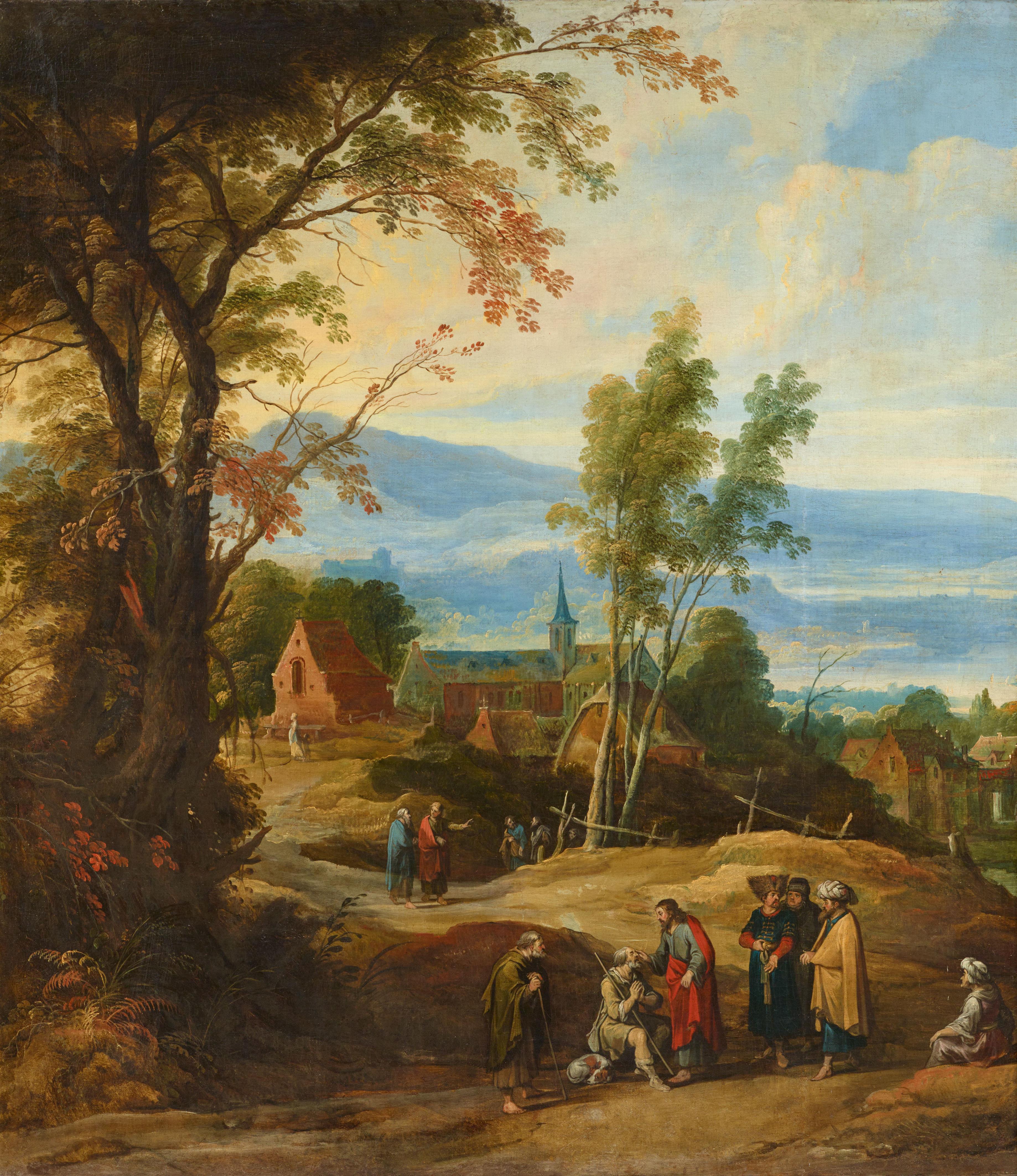Joos de Momper
Christ Healing the Blind Man
Oil on canvas (relined). 137 x 121 cm.
This large-format painting shows a varied landscape with a Biblical scene in the foreground. The viewer's gaze is initially drawn in by the tall trees on the left-hand edge of the picture into a wide, light-filled landscape, in the middle ground of which one sees a village with numerous houses and a monastery church. A lake landscape stretches out behind it, merging into mountains painted in light blue tones. At the lower edge of the picture, several figures are depicted as if on a stage. The group shows Christ healing a blind man, as told in the Gospel of John (Chapter 9). Christ, emphasised by an aura of light around his head, lays his hand on the eyes of a seated man in beggar's clothing, thereby bringing about his healing.
In his groundbreaking catalogue raisonné on Joos de Momper, published in 1983, Klaus Ertz dedicated a full-page colour illustration to the present painting. Unlike his contemporaries Jan Brueghel the Elder and Roelant Savery, Momper devoted himself exclusively to landscape painting and "can be considered the finest and most successful landscape painter of his time" (Ertz in: exhib. cat. Die flämische Landschaft 1520-1700, Essen and Vienna 2003/04, p. 144). Ertz dated the present painting to the end of the 1620s, i.e. to the late period of the artist, who died in 1635. In this phase, his brushwork becomes more fluid and the application of colour more spontaneous, which lends the works a more modern character.
Due to this more modern impression, Claus Grimm (op. cit.) has recently suggested an attribution to the younger Antwerp painter Jan Wildens, who worked closely with Rubens and contributed the landscape background to numerous paintings by the Rubens workshop. The figures in the present painting are unanimously attributed to the Antwerp artist Hans Jordaens III (c. 1595-1643), who was also in demand as a figure painter among numerous other Flemish artists. "His depictions of people and animals, painted in just a few confident strokes, illustrate his large repertoire of expressive studies of movememt." (Grimm, op. cit., p. 33).
A second version of the present composition (fig. 1 in Grimm op. cit., p. 32), which surfaced in England a few years ago, shows a larger section of landscape on the right-hand side. This is a later variant for which the present work, which Grimm refers to as the prime version and which was probably shortened on the right-hand side at a later date, formed the model.
Provenance
Collection Dr Hans Wetzlar, Amsterdam. - West Collection, Cornwallis. - Kunsthandel Hans M. Cramer, The Hague, 1965/66, no. 28 - Auctioned by Sotheby's, London, 3 December 1969, lot 52 - German private collection.
Literature
Klaus Ertz: Josse de Momper der Jüngere (1564-1635). Die Gemälde mit kritischem Oeuvrekatalog, Freren 1986, p. 558, no. 336, full-page colour illus. p. 556 - exhib. cat. "Chambre Privée", Aachen, Suermondt-Ludwig-Museum, 8 Nov. 2018-3 Feb. 2019, no. 5, pp. 29-33 (as Jan Wildens and Hans Jordaens III).
Exhibitions
Chambre Privée, Aachen, Suermondt-Ludwig-Museum, 8.11.2018-3.2.2019.

